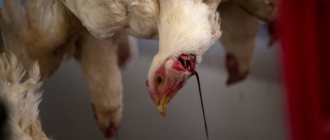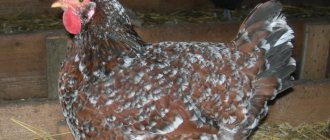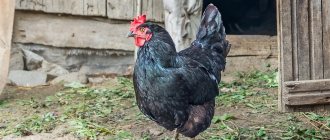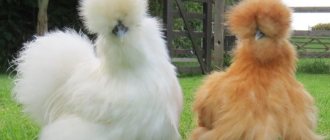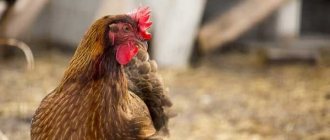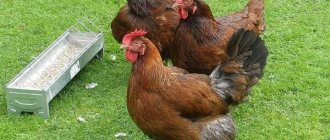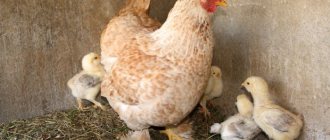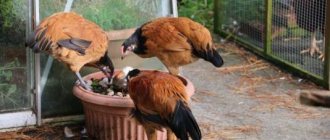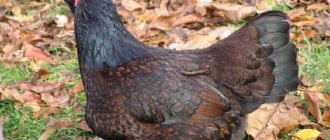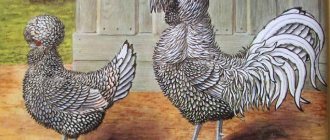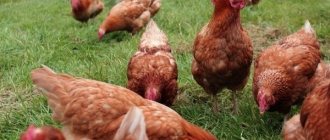Selection work in poultry farming is an extremely complex, labor-intensive and lengthy process, which is why every success in this area is so valued. In domestic selection over the past 30 years, only one breed of chickens has been bred - Pushkin, but this has become an achievement that has received recognition and high praise throughout the world.
Created to increase egg production, it showed such good results in meat production that it was immediately classified as a breed of egg-meat breed.
Pushkin striped-motley breed.
How the Pushkin chicken breed was developed
The breeding of Pushkin chicken began in 1976 in an experimental farm at the Research Institute of the USSR Academy of Agricultural Sciences. The base was located in the city of Pushkino, Leningrad region, which gave the name to the breed.
The starting materials were:
- black and motley australorps , characterized by high productivity, rapid maturation and increased body weight;
- Dutch Shaver Whites 288, unpretentious and egg-laying;
- leghorns.
The resulting offspring were later crossed with broilers-6 to improve meat characteristics and Russian white chicken, which increased the growth of the bird, increased its adaptability to local climatic conditions and formed an easy-going, calm character.
In the 80s Genetic scientists from Zagorsk near Moscow (now the city of Sergiev Posad) joined the selection, focusing on increasing egg production rates.
This was the reason for the creation of 2 lines in the breed - St. Petersburg and Moscow - with differences in the speed of maturation, productivity and sires. The breeding work lasted 40 years, and only in 2007 the Pushkin striped-motley was officially entered into the State Register of the Russian Federation.
Poultry Standards
Representatives of the Pushkin breed have a straight, proud posture due to a small head on a long neck, a wide massive back and a vertically raised tail.
Descriptions of purebred chickens include:
- large, trapezoidal body with elongated legs;
- the plumage is gray-white in color (Moscow hens have distinct stripes; St. Petersburg hens also have them, but are somewhat blurred);
- rose-shaped (in St. Petersburg) or leaf-shaped (in Muscovite) crest;
- earrings of white or pale pink color;
- strong muscular legs;
- short wings pressed to the body;
- paws with widely spaced toes pale yellow or pink;
- slightly curved small beak of a light gray shade;
- amber, bright yellow eyes.
Cockerels are lighter than hens. They are distinguished by almost completely white plumage with gray specks. Females are smaller and darker. The weight of an adult chicken is 1.8-2.3 kg, a rooster - 2.5-3 kg.
On average, one representative of the Pushkin breed, starting from 5 months of age, produces 200 eggs per year, 50-60 g each. Record holders can reach 260-270 eggs, and with age, their eggs become larger and change the color of the shell from beige to light. The productive period with proper care and proper feeding lasts 3-4 years.
Pushkin breed cockerels and hens.
St. Petersburg line
Piterkas are distinguished by a rose-shaped crest borrowed from the Russian white, which is less susceptible to frostbite in extreme cold conditions. They grow, fledge and mature faster.
The addition of blood from broilers and Russian white chickens was required when, contrary to the expectations of scientists, the resulting hybrids showed a drop in egg production. This corrected the situation and additionally gave weight gain.
St. Petersburg chickens with a pink comb.
Moscow selection
The selection policy of Sergiev Posad geneticists was based on strict selection for weight and productivity. As a result, chickens of this line are more fertile and produce on average up to 220 eggs per year.
But their sizes are smaller, and the ridge has a leaf-shaped shape. And if the St. Petersburg breed is classified as an egg-meat breed, then the Moscow breed is strictly an egg breed.
Both lines are actively mixing, and it can be assumed that the breed will soon be unified and the existing differences will be eliminated.
Egg breed of Pushkin chickens of Moscow selection.
Productivity
Laying hens of this breed mature at 4 months. The fertilization rate of quons reaches 90%. Every year, chickens bring 220-250 eggs to their owners. However, some farmers report higher numbers - 270-290 eggs per year. The weight of the products is 55-60 grams, the egg shells are colored light beige. The eggs are quite large in size. Weather and climatic conditions do not affect the masonry process.
On a note! Chickens lay eggs most actively in the first year of life. High rates persist for 3-4 years, and then sharply decrease. In this regard, it is necessary to prepare pullets in advance to replace tired stock.
Poultry meat is in great demand among chicken lovers. The carcasses look very attractive due to the snow-white skin of the body, without specks or an unpleasant yellow tint. The tender and juicy taste of the meat is also appreciated.
Extra cockerels are usually slaughtered. The females are left to receive eggs. Most are sent for sale, while others are placed in an incubator to raise new offspring.
Pushkin chickens are long-lived. Given good living conditions, proper nutrition and disease prevention, they can live 10-12 years. But breeders decide for themselves whether it makes sense to keep the bird for so long. Typically, herds are replaced every 4-5 years in order to maintain momentum in the production of meat and eggs. However, some individuals are left to decorate the poultry yard.
Possible defects of St. Petersburg and Moscow chicken lines
Representatives of the Pushkin breed are distinguished by their kind, flexible character. They are responsive, get used to their owners and even allow themselves to be held.
But the lack of aggression resulted in a decrease in the instinct of self-preservation. In case of danger, chickens do not defend themselves or try to escape, but freeze helplessly in place.
The same thing happened with the brooding instinct, which was partially lost during selection. Laying hens hatch eggs for no more than 2 weeks, which is why the creation of an incubator is required to breed livestock on a farm or in a private household.
Another disadvantage is the tendency to overeat. It affects the egg production of the bird. This is expressed first in the appearance of large 2-yolk eggs, then in a drop in their number, and after that in the complete cessation of laying.
When working on the striped-pied, it was planned to consolidate the sign of lack of flying skills. Some individuals lacked flight feathers, which made it possible to declare the Pushkin breed as flightless.
However, it was not possible to consolidate this property, and today a chicken can easily overcome a one and a half meter fence. Therefore, it is recommended to make enclosures for walking birds covered, which additionally creates protection from attacks by predators.
The breed and its productive characteristics can be spoiled by allowing owners of characteristics that do not meet the standard for breeding:
- differences in the shape of the body;
- hunchback;
- the predominance of black feathers in the plumage;
- yellow undergrowth;
- lush and excessively enlarged “squirrel” tail.
Carriers of such recessive characteristics tend to return to the original breeds with their inherent disadvantages.
Chickens can fly over a 1.5 m fence.
Necessary conditions of detention
A distinctive feature of Pushkin breed chickens is their unpretentiousness. For normal development and existence, it is enough to follow the standard rules for caring for poultry.
It should be taken into account that keeping fluff in cages and the associated sedentary lifestyle can negatively affect productivity.
Laying hens are prone to obesity, which immediately affects egg production.
Dry closed chicken coops with an attached aviary for walking are best suited for keeping birds. Dampness and drafts provoke diseases and, despite the good immunity of chickens, can be detrimental to the livestock.
External environment and temperature
The breed adapts well to low temperatures, and therefore, when organizing a poultry house, there is no need to invent and install a heating system.
It is enough to eliminate all the cracks and carefully monitor the humidity, which should not exceed 55-60%. Although for the northern regions it is recommended to choose representatives of the St. Petersburg line, whose rose-shaped crest is almost not susceptible to frostbite.
Birds feel most comfortable at room temperature, and continue to lay eggs even after the mark on the thermometer drops below the critical +16°C.
With a small population of 20-25 chickens, natural ventilation of the room is sufficient, but with a larger number, forced ventilation is required to free the room from accumulating harmful fumes.
Chickens stop laying eggs if the daylight hours become less than 14 hours. Therefore, artificial lighting (preferably adjustable) must be present in the poultry house. During the warm season, birds benefit from movement and being in the fresh air.
The chicken coop should be dry and warm enough.
Arrangement of a walking yard
The Pushkin breed is not prone to long walks, and therefore can be kept in an unfenced yard.
But if the owner plans to build an enclosure, he must provide for the following subtleties:
- the fence or mesh cannot be less than 1.5 m in height;
- a canopy that protects the bird from rain or direct sunlight is desirable;
- chickens need a “bathing” area, which means a sandbox;
- It is recommended to sow the walking space with nettles or clover, which become a source of vitamins for the birds in the spring.
The walking yard should have a swimming area.
Chicken coop from the inside
Organizing the internal space of the poultry house involves installing perches 40-60 cm high, creating special places for laying eggs, and equipping an ash-sand bath.
The Pushkin Striped Pied was planned as a flightless breed, and therefore it was intended to be kept outdoors. However, practice has shown that chickens are happy to fly up to small roosts and feel comfortable there.
The floor should be lined with a 10 cm layer of straw to preserve heat and ease movement.
Bulk materials (sand, sawdust, etc.) are not suitable due to the bird’s special predilection for rummaging in the ground until solid soil is discovered. After 2-3 days, such a chicken coop floor will be torn up, lose its functional properties, and will have to be replaced.
Nests for laying (at the rate of 1 box for 3-4 laying hens) are placed in shaded places. Chickens do not lay eggs where there is direct light, or in complete darkness. It is also recommended to line the inside of the nesting site with straw.
An ash and sand bath helps the bird get rid of skin parasites and insects that breed in the floor litter. A separate feeding area will be organized.
It is recommended to cover the floor of the chicken coop with straw.
Equipment for drinking bowls and feeders
Feeders are installed in such a way that all birds have free access to food. The design should not allow chickens to sit on the edges or climb inside.
To do this, they install protective nets that allow you to stick your head through the food, but make it difficult to use the feeder as a perch. Drinking bowls are made at the rate of 0.5 liters of water per day per 1 individual.
For this breed, it is better to use floor feeders made of plastic or metal. Wooden ones get wet when filled with liquid mash.
The most important condition is maintaining cleanliness in the poultry house, for which washing and disinfection of feeders for dry food is recommended once every 2-3 days, and for wet food - every day.
It is most convenient to place greens, tufts of grass, and branches along the walls of the chicken coop, hanging them low above the floor.
Types of possible drinkers and feeders.
Shedding period
The natural process of feather change in poultry is accompanied by a decrease in tone, loss of attractive appearance and a decrease in egg production.
It takes just over 1 month a year, after which the laying hen’s physical fitness and productivity are completely restored. But during this period, it is necessary to show more attention to the chickens, feed them with meat and fish broths, and introduce a high fat content into the diet.
Necessary break in egg production
The Pushkin striped-motley matures in 165 days and from this age begins to lay eggs. The eggs are small at first and weigh no more than 50 g.
The duration of egg laying is 3-4 years (for other popular breeds - 2-2.5 years), and this process occurs almost without interruption.
A decrease in egg production can only be observed in the following cases:
- molting period;
- drop in room temperature below +10°C;
- defeat by an infectious or viral disease;
- binge eating;
- protein imbalance during feeding.
Positive and negative traits
To begin with, we list the main advantages of this breed of chickens:
- Excellent presentation of chicken carcass.
- Calm behavior of birds. This makes them easy to catch.
- Excellent endurance even in harsh climatic conditions.
- Unpretentiousness. The food and contents do not have any special characteristics.
- Suitable for keeping in open-type enclosures.
Now let's talk about the disadvantages. The only negative is the difficulty of purchasing. Chickens from private breeders may not be purebred - this is bad if you plan to engage in breeding. And factory workers are characterized by excessive timidity. This may have a negative impact on productivity.
Now you know all the features, advantages and disadvantages of such a breed of chickens as Pushkinskaya. Based on the above, we can conclude that chickens are quite unpretentious.
Purchasing such a breed is the best option for growing on a home farm. Birds will delight you with a large number of eggs laid and excellent quality meat. The lifespan of such birds is about twelve years.
Breeding Pushkin chickens
With the loss of the brooding instinct, breeding striped-pied is impossible without an incubator. Eggs from hens that lay eggs for at least 10-12 months are laid in it.
The egg itself should be medium in size, neat in shape, without cracks or calcified growths on the shell. Freshness is important. If it was stored for more than 5 days, the percentage of chicks hatching decreases sharply.
Pushkin roosters are distinguished by their activity and love of love. They begin to show interest in females from 5 months, and each is capable of supporting up to 25 hens.
For comparison, males of other breeds need 5-6 girlfriends. Therefore, when breeding livestock, you should adhere to the ratio of roosters and hens in a flock of 1:20-25, otherwise conflicts and fights are possible in the chicken coop. The fertility of eggs is stated to be 80%, but in practice it is 90-95%.
The humidity level in the incubator and the temperature regime are standard, but the chicks appear a day earlier - 20 days after laying.
Rooster of the Pushkin chicken breed.
Chick care
Chicks require special care in the first 3 weeks. They are placed in insulated boxes - brooders, reliably protected from drafts, where the temperature must be maintained at +30...+33°C.
Every week it is reduced by 2-3°C. In the first days of life, chicks require round-the-clock lighting. They are accustomed to the dark gradually, increasing the time the lighting device is turned off every day.
The floor is lined with moisture-absorbing material (softwood sawdust is best), and a drinking bowl is placed in the corner. Its design should provide chickens with free access to water, from which they receive the first vitamins and minerals, but protect it from accidental falls.
A baby caught in water may choke and die.
The comfort of the conditions is determined by the appearance and behavior of the chicks. Drowsiness, inactivity, splayed feathers indicate a violation of the humidity regime or elevated temperature.
Chickens of the Pushkin breed of chickens.
Advantages and difficulties of growing
Difficulties in raising and keeping poultry rarely arise. The only inconvenience for the chicken breeder is the need for four feedings a day and the predominance of roosters in the brood, which somewhat complicates the task when obtaining a flock of laying hens. Sometimes the overly calm nature of the bird is also called a minus.
Pushkin breed of chickens
It causes a delayed reaction, which makes Pushkin chickens easy prey for birds of prey, dogs and large cats.
| pros | Minuses |
| High quality meat | Excessive rooster activity |
| Large egg | Lack of parental instinct in chickens |
| Disease resistance | Large percentage of roosters in the brood |
| Cold resistance | Obesity due to poor nutrition |
| Calm disposition (sometimes a minus) | Egg pecking due to poor diet |
| High egg fertility | |
| Good chick survival |
Depending on the goals of the poultry farmer and what he expects from the bird, he determines whether the positive or negative qualities of the Pushkin chicken are of greater importance to him. The breed cannot be called ideal, and its characteristics indicate a number of shortcomings.
The breed cannot be called ideal
Diet and feeding regime
The first feeding is done 5-7 hours after birth. The chickens are given a finely crushed boiled egg. To prevent the lumps from sticking together, sprinkle them with a small amount of semolina.
Gradually add to the diet:
- finely chopped nettles, onions and clover;
- boiled millet cereal (later replaced with crushed wheat or corn);
- low-fat cottage cheese with the addition of bone or fish meal.
For young animals
Feeding of young animals lasts 4.5-5 months.
Add to the diet:
- boiled vegetables (potatoes, carrots, turnips);
- boiled fish;
- whey;
- vitamin supplements.
All this time, Pushkin birds demonstrate intensive growth and grow from 60-gram chicks into hens weighing 1.6-1.9 kg. At this age, non-standard females and excess males are removed from the herd, of which too many are born compared to other breeds.
They are used for meat because the weight gain slows down, stabilizes and further maintenance of culled individuals is unprofitable.
For adult birds
Keeping Pushkin chickens only on grain and mixed feed is unacceptable due to their tendency to obesity. The menu should be varied with greens, bran, grass, and fermented milk products.
Meat and fish waste from the owner's table goes well with bulk feed and mash. Mineral and vitamin supplements must be included in food.
The lack of vitamin K leads to cannibalism among birds, and the lack of calcium leads to laying hens pecking at the shells of newly laid eggs. To avoid this, it is recommended to leave pieces of chalk or lime in the house.
Small pebbles, gravel or shell rocks that enter the bird's stomach help improve digestion. They help grind rough food, for which poultry farmers prudently scatter them in an aviary or chicken coop.
Feeding regimen 4 times a day:
- In the morning it is recommended to give 1/3 of the daily grain requirement.
- At noon they give a mash of bran with vegetables.
- Top dressing consists of grass, potatoes, carrots, and onions.
- In the evening, feed the rest of the grain feed.
Feed volumes are determined in practice: if the feeder quickly becomes empty (15-20 minutes), the norms should be increased; If there are leftovers, reduce.
Uneaten food should not remain in the feeders for a long time, especially in hot weather. The sour residues contain pathogenic microbes that can cause a stomach infection.
Feeding the bird.
What diseases are they susceptible to?
The breed is distinguished by its immunity to colds and good survival rate of chicks (up to 90%). Losses from infectious diseases in adult chickens amount to up to 15% of the population.
The greatest danger to birds is:
- Newcastle disease (pseudoplague), which is accompanied by diarrhea with blood, shortness of breath, wheezing when breathing. The comb turns cherry red.
- Marek's disease. It manifests itself in loss of coordination, swelling of the joints, and curling of the fingers inward. It mainly affects young animals at 5-7 months of age.
- Bird pox. The virus enters the body through poor-quality food or through contact with a carrier of the disease.
- Paratyphoid. An eye disease that affects the sclera. The eyes become red and become purulent.
- Avitaminosis. Caused by an imbalance in the composition of the feed and a lack of vitamins. Leads to damage to the skin, paws, liver, and lungs.
Timely vaccination, proper nutrition and care help avoid diseases. This is facilitated by keeping the poultry house clean, as well as complete disinfection of the premises, including anthelmintic treatment, at least 2 times a year.
Vitamin deficiency in chickens.
Possible diseases
Although chickens of the Pushkin breed, having strong immunity, are very resistant to both colds and infectious diseases, they are nevertheless sometimes capable of getting sick:
- salmonellosis , to which chickens are more often exposed and the 20-day treatment for which consists of adding Furazolidone tablets dissolved in 3 liters of water to the bird's drinker;
- pullorosis , which is also called typhus and is treated with antibiotics in the form of Neomycin or Biomycin;
- pasteurellosis , or avian cholera, which is treated with sulfonamides in the form of Sulfamethazine, added to bird feed at the rate of 0.5% of the feed volume;
- infectious bronchitis , which is treated by spraying an aerosol with chloroturpentine;
- mycoplasmosis , which is fought with antibiotics in the form of Chlortetracycline and Oxytetracycline, added to poultry feed for 7 days in the amount of 0.4 g of the drug per kilogram of feed.
This wonderful breed of chickens is gaining more and more fans in private farms due to its high productive qualities and its peaceful and human-friendly character.
Active link to the source - be sure to look at the information from the original source fermer.blog
Cost of Pushkin chickens
You should purchase eggs, chickens or young animals for breeding the breed only from producers with a good reputation. Before the transaction, it is advisable to familiarize yourself with the parental photos of the proposed bird, the conditions of its maintenance, and the price order.
Buying from an unverified private seller always means spending money on a low-quality, not purebred product.
Average prices in 2021:
- for an incubator egg - 70-90 rubles;
- for a one-day-old chicken - 100-160 rubles. (+ 5-10 rubles for each feeding day);
- for a week - 200-250 rubles;
- for a young (0.5-1 year) laying hen - about 1 thousand rubles.
Pros and cons of poultry
Pushkin chickens are most suitable for breeding in private and private farms.
Their advantages include:
- rapid ripening;
- disease resistance;
- strong immune system;
- high performance;
- taste characteristics of meat;
- calm, flexible character;
- unpretentiousness;
- adaptive properties to weather and temperature conditions.
Relative disadvantages can be considered:
- quantitatively large, in comparison with the source materials, hatching of cockerels and their increased activity in adulthood;
- reluctance of hens to hatch chicks.
The breed has received many positive reviews from specialists and ordinary owners.
Reviews about the breed
The Pushkin breed of chickens is an ideal option for a private farm, as evidenced by reviews from poultry farmers. Oksana from the village of Kamenoye notes that the declared productivity of these birds corresponds to reality, and the resulting eggs are even larger than she expected. The woman declares that Pushkin’s chickens are unpretentious and get along well with each other in the chicken coop, but they can hardly be called melancholy. Birds love to be active, take off, but catching them in the yard is not so easy - they run away.
Vasily from the Siberian hinterland emphasizes that Pushkin's laying hens are not afraid of the cold. In frosty winters, chickens do not freeze even without heating devices. The main thing is to insulate the walls, roof and floor well.
Laying hens of the Pushkin breed are worthy of the attention of poultry farmers living in the regions of the middle zone. They are not afraid of the cold, are unpretentious to living conditions and feed, and are highly productive, providing their owners with large eggs and tasty meat.
